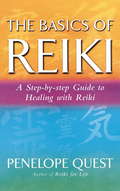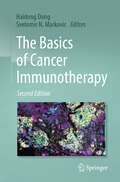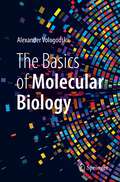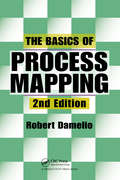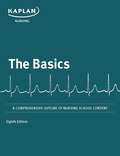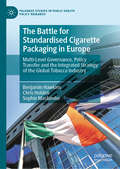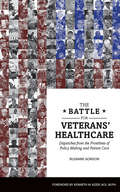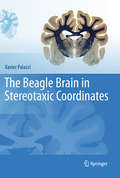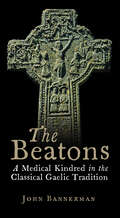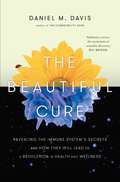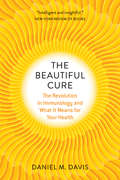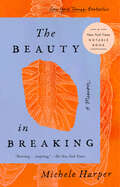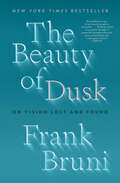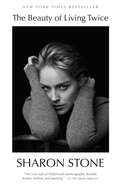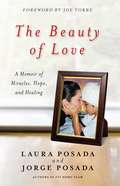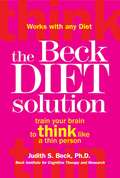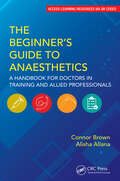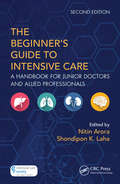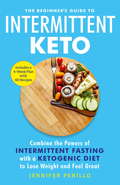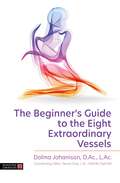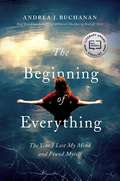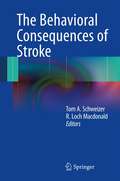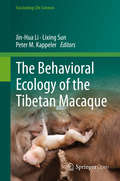- Table View
- List View
The Basics Of Reiki: A Step-By-Step Guide to Reiki Practice
by Penelope QuestThe Basics of Reiki by Penelope Quest offers a clear and accessible introduction to an increasingly popular and powerful healing art. Best known as a gentle hands-on-healing technique for physical ailments, Reiki is also a holistic system which can be used for healing body, mind, emotions and spirit. In this helpful and easy-to-follow book, you will discover everything you need to know, including: the origins and development of Reiki as a healing system; what to expect when receiving a Reiki treatment; how Reiki treats both the symptoms and the causes of illness, easing physical pain and helping to clear emotional blockages; how easily you can be attuned to Reiki, and what to expect at each level of training; how to use Reiki for self-healing and for healing other people, animals, plants and the environment; practical exercises and visualisations to encourage relaxation and develop insight and energy awareness. This is the perfect choice for those who want to find out more about Reiki and the benefits it can offer, from a highly qualified and experienced Reiki Master.
The Basics Of Reiki: A step-by-step guide to reiki practice
by Penelope QuestThe Basics of Reiki by Penelope Quest offers a clear and accessible introduction to an increasingly popular and powerful healing art. Best known as a gentle hands-on-healing technique for physical ailments, Reiki is also a holistic system which can be used for healing body, mind, emotions and spirit. In this helpful and easy-to-follow book, you will discover everything you need to know, including: the origins and development of Reiki as a healing system; what to expect when receiving a Reiki treatment; how Reiki treats both the symptoms and the causes of illness, easing physical pain and helping to clear emotional blockages; how easily you can be attuned to Reiki, and what to expect at each level of training; how to use Reiki for self-healing and for healing other people, animals, plants and the environment; practical exercises and visualisations to encourage relaxation and develop insight and energy awareness. This is the perfect choice for those who want to find out more about Reiki and the benefits it can offer, from a highly qualified and experienced Reiki Master.
The Basics of Cancer Immunotherapy
by Haidong Dong Svetomir N. MarkovicThis comprehensively updated new edition provides patients and their physicians (especially non-oncologist healthcare providers) with a clear and concise introduction to cancer immunotherapy. Unlike traditional forms of cancer therapy, immunotherapy acts by boosting the patient’s own immune system to fight cancer; immunotherapy's unique features make its management, monitoring and side-effects different from those of traditional cancer therapy. Especially novel are the side effects of cancer immunotherapy, necessitating greater awareness for both patients and physicians in order to minimize complications and maximize benefits. The patient-friendly and state-of-the-art knowledge presented in this book will inform patients and their care providers about the benefits and risks of cancer immunotherapy, and help them to understand how immunotherapy would control their unique disease. Researchers and academic professionals in the field of cancer immunotherapy will also find clear, useful information to help them communicate with patients and address unresolved issues. Key features include: Expertise. Editors and authors are scientists and oncologists specializing in cancer immunotherapy, involved in scientific discovery from the early stage of immune-checkpoint inhibitors to today's patient care. Their insights, expertise and experience guarantee high quality and authority in the science, medicine and practice of cancer immunotherapy. Patient-friendly. This book is written specifically for cancer patients considering or undergoing immunotherapy. As an educational tool, this book will help the reader to understand the underlying science, balance the risks and benefits based on both research and clinical facts, and make an informed decision regarding their treatment options. Disease Specificity. Cancer is a complicated disease involving multiple stages and pathology. Its response to immunotherapy is individualized and varies depending on cancer types. The authors’ expertise in treating different types of cancers, including melanoma, lung, kidney, bladder, breast, and lymphoma, provides disease-specific insights in applying immunotherapy to each disease. State-of-the-Art. This edition has been comprehensively updated to reflect recent advances, including detailed coverage of the latest therapies like CAR-T, TIL, immune checkpoint inhibitors and bispecific T cell engaging antibodies, and dedicated chapters on breast cancer, solid organ transplant recipients, GI and genitourinary malignancies, and resistant cancer. Aimed at patients and non-oncologist care providers as a resource when seeking immunotherapy as a treatment option Detailed focus on various cancers provides disease-specific insights, clinical studies, and risk/benefit analysis Comprehensively updated to address the latest immunotherapies and expanded coverage of disease-specific scenarios
The Basics of Molecular Biology
by Alexander VologodskiiAccessible and comprehensive, this book describes the universal cellular nature of living organisms and is an indispensable tool for anyone in the sciences who wishes to get a quick overview of molecular biology. Individual chapters cover nucleic acids and proteins, genetic code and protein synthesis, the fidelity of transferring genetic information to the next generations, and the regulation of various processes inside the cells. Special attention is paid to new areas rising from modern DNA sequencing technologies which transform biology. The book also touches on developing areas, such as cures for cancer and CRISPR, which are important for medicine and the future of humankind.
The Basics of Process Mapping
by Robert DamelioThis book provides how-to guidance and examples for three types of maps, namely relationship map, cross-functional process map, and flowchart. It helps readers to effectively apply all three types of maps to make work visible at the organization, process, and job/performer levels.
The Basics: A Comprehensive Outline of Nursing School Content (Kaplan Test Prep)
by Kaplan NursingKaplan&’s The Basics provides comprehensive review of essential nursing school content so you can ace your assignments and exams. The Best Review All the essential content you need, presented in outline format and easy-access tables for efficient reviewChapters mirror the content covered in your nursing school curriculum so you know you have complete content coverageUsed by thousands of students each year to succeed in nursing school and beyondExpert GuidanceKaplan&’s expert nursing faculty reviews and updates content annuallyWe invented test prep—Kaplan (www.kaptest.com) has been helping students for 80 years. Our proven strategies have helped legions of students achieve their dreams.
The Battle for Standardised Cigarette Packaging in Europe: Multi-Level Governance, Policy Transfer and the Integrated Strategy of the Global Tobacco Industry (Palgrave Studies in Public Health Policy Research)
by Chris Holden Benjamin Hawkins Sophie Mackinder"This book is essential reading for researchers of tobacco policy change. Too many studies simply complain that change is too slow because tobacco companies are too powerful and politicians lack the will to challenge them. This book goes much further, to help us understand not just industry strategy but the policy processes in which policy advocates engage, learn from each other, and help create essential global tobacco policy change."Paul Cairney, University of Stirling, UK"This book is rare in making genuinely significant contributions across both public health and policy studies. By focusing on the battle for standardised packs, it engagingly addresses one of the most prominent recent innovations in health policy that has relevance both beyond Europe and across multiple spheres of health policy. In doing so, it also offers an innovative analysis of the role of transnational corporations in policy transfer."Jeff Collin, University of Edinburgh, UKThis book analyses the battle for standardised cigarette packaging (‘plain packaging’) in Europe, drawing on the concepts of multi-level governance and policy transfer. It analyses the strategies of policy makers, non-governmental organisations and transnational tobacco companies in attempting either to advance or to block the introduction of standardised packaging. Taking a global and multi-level approach, it analyses these struggles within European Union institutions, EU member states, and across jurisdictions, as NGOs and tobacco companies worked transnationally to counter each other. As well as presenting original empirical research detailing these policy battles, the book provides new theoretical insights into policy transfer processes, particularly within multi-level polities, showing how transnational corporations can have dramatic effects on these processes. The book will appeal equally to public health researchers, policy analysts and political scientists.
The Battle for Veterans’ Healthcare: Dispatches from the Front Lines of Policy Making and Patient Care
by Suzanne GordonIn The Battle for Veterans' Healthcare, award-winning author Suzanne Gordon takes us to the front lines of federal policymaking and healthcare delivery, as it affects eight million Americans whose military service makes them eligible for Veterans Health Administration (VHA) coverage.Gordon’s collected dispatches provide insight and information too often missing from mainstream media reporting on the VHA and from Capitol Hill debates about its future. Drawing on interviews with veterans and their families, VHA staff and administrators, health care policy experts and Congressional decision makers, Gordon describes a federal agency under siege that nevertheless accomplishes its difficult mission of serving men and women injured, in myriad ways, while on active duty.The Battle for Veterans’ Healthcare is an essential primer on VHA care and a call to action by veterans, their advocacy organizations, and political allies. Without lobbying efforts and broader public understanding of what’s at stake, a system now functioning far better than most private hospital systems may end up looking more like them, to the detriment of patients and providers alike.
The Beagle Brain in Stereotaxic Coordinates
by Xavier PalazziThis is an up-to-date atlas of the stereotaxic coordinates of the beagle brain. It provides stellar illustrations of the organization of nerve tracts and the morphology of the nuclei that compose the central nervous system.
The Beatons: A Medical Kindred in the Classical Gaelic Tradition
by John BannermanThis book traces the Clann Meic-bethad or Clan MacBeth whose members practised medicine in the classic Gaelic tradition in various parts of Scotland from the early fourteenth to the early eighteenth century. From many medieval Gaelic manuscripts known to have been in their possession, individual members of the clan and their activities are identified. Sometime in the second half of the sixteenth century the kindred began to adopt Beaton as a surname for use in non-Gaelic contexts. The medical Beatons fell naturally into two divisions: one confined mainly to the Western Isles and the other to the mainland of Scotland. This detailed study of the Beatons and their medicine describes how the position of medical doctor was inherited by the eldest son, and potential Beaton physicians were sent out to be trained by other members of the family for several years before undertaking their own practice. The book provides information on medieval medicine at the highest levels of Highland society.
The Beautiful Cure: Revealing the Immune System's Secrets and How They Will Lead to a Revolution in Health and Wellness
by Daniel M. DavisA leading expert explains how discoveries about the immune system are leading the way to a revolution in beating cancer and other diseases.The immune system holds the key to human health. The scientific quest to understand how it works--and how it is affected by stress, diet, sleep, age, exercise and our state of mind--is now unlocking a revolutionary new approach to medicine and well-being. The body's ability to fight disease and heal itself is one of the great mysteries and marvels of nature, but within the last few years, painstaking research has resulted in major advances in our understanding of the immune system, revealing an inner world of breathtaking sophistication, complexity and beauty. Far more powerful than any medicine ever invented, it also plays a crucial role in our daily lives. Already we have found ways to harness these natural defences to create break-through drugs and therapies that can beat cancer, diabetes, arthritis and many age-related diseases, and we are starting to understand how activities such as mindfulness might play a role in enhancing our physical resilience. Written by an expert at the forefront of this adventure, The Beautiful Cure tells a dramatic story of detective work and discovery, of puzzles solved and of the mysteries that remain, of lives sacrificed and saved, introducing the reader to this revelatory new understanding of the human body and what it takes to be healthy.
The Beautiful Cure: The Revolution in Immunology and What It Means for Your Health
by Daniel M. Davis&“A terrific book by a consummate storyteller and scientific expert considers the past and future of the body&’s ability to fight disease and heal itself.&” —Adam Rutherford, The Guardian The immune system holds the key to human health. In The Beautiful Cure, leading immunologist Daniel M. Davis describes how the scientific quest to understand how the immune system works—and how it is affected by stress, sleep, age, and our state of mind—is now unlocking a revolutionary new approach to medicine and well-being. The body&’s ability to fight disease and heal itself is one of the great mysteries and marvels of nature. But in recent years, painstaking research has resulted in major advances in our grasp of this breathtakingly beautiful inner world: a vast and intricate network of specialist cells, regulatory proteins, and dedicated genes that are continually protecting our bodies. Far more powerful than any medicine ever invented, the immune system plays a crucial role in our daily lives. We have found ways to harness these natural defenses to create breakthrough drugs and so-called immunotherapies that help us fight cancer, diabetes, arthritis, and many age-related diseases, and we are starting to understand whether activities such as mindfulness might play a role in enhancing our physical resilience. Written by a researcher at the forefront of this adventure, The Beautiful Cure tells a dramatic story of scientific detective work and discovery, of puzzles solved and mysteries that linger, of lives sacrificed and saved. With expertise and eloquence, Davis introduces us to this revelatory new understanding of the human body and what it takes to be healthy. &“Visceral.&” —The Wall Street Journal &“Illuminating.&” —Publishers Weekly &“Heroic.&” —Science
The Beauty in Breaking: A Memoir
by Michele HarperAn emergency room physician explores how a life of service to others taught her how to heal herself.Michele Harper is a female, African American emergency room physician in a profession that is overwhelmingly male and white. Brought up in Washington, D.C., in a complicated family, she went to Harvard, where she met her husband. They stayed together through medical school until two months before she was scheduled to join the staff of a hospital in central Philadelphia, when he told her he couldn't move with her. Her marriage at an end, Harper began her new life in a new city, in a new job, as a newly single woman.In the ensuing years, as Harper learned to become an effective ER physician, bringing insight and empathy to every patient encounter, she came to understand that each of us is broken--physically, emotionally, psychically. How we recognize those breaks, how we try to mend them, and where we go from there are all crucial parts of the healing process. The Beauty in Breaking is the poignant true story of Harper's journey toward self-healing. Each of the patients Harper writes about taught her something important about recuperation and recovery. How to let go of fear even when the future is murky. How to tell the truth when it's simpler to overlook it. How to understand that compassion isn't the same as justice. As she shines a light on the systemic disenfranchisement of the patients she treats as they struggle to maintain their health and dignity, Harper comes to understand the importance of allowing ourselves to make peace with the past as we draw support from the present. In this hopeful, moving, and beautiful book, she passes along the precious, necessary lessons that she has learned as a daughter, a woman, and a physician.
The Beauty of Dirty Skin: The Surprising Science of Looking and Feeling Radiant from the Inside Out
by Whitney BoweInternationally renowned dermatologist and research scientist Dr. Whitney Bowe presents, for the first time, the connection between a healthy gut and radiant, clear skin, with a 21-day program to maximize skin health and beauty.Every year, nearly 80 million Americans will consult their doctors about their skin. In fact, skin disorders beat out anxiety, depression, back pain, and diabetes as the number one reason Americans see their doctors. Unfortunately, however, the vast majority will receive only a surface-level treatment, leaving the underlying conditions at the root of their skin issues unresolved. Skin doesn't lie; it reflects overall health in unimaginable ways.In The Beauty of Dirty Skin, internationally renowned dermatologist and scientist Dr. Whitney Bowe shows readers that skin health is much more than skin deep. As a pioneering researcher on the cutting edge of the gut-brain-skin axis, she explains how the spectrum of skin disorders -- from stubborn acne and rosacea to psoriasis, eczema, and premature wrinkling -- are manifestations of irregularities rooted in the gut. Lasers, scalpels, creams, and prescription pads alone will not guarantee the consistently healthy, glowing skin we all seek. Instead, Dr. Bowe focuses on the microbiome -- where trillions of microbes "speak" to your skin via the brain -- and highlights the connection between sleep, stress, diet, gastrointestinal health, and the health of your skin. With simple explanations of the science, do-it-yourself practical skincare strategies, and a life-changing 21-day program, The Beauty of Dirty Skin is your roadmap to great skin from the inside out and the outside in.
The Beauty of Dusk: On Vision Lost and Found
by Frank BruniFrom New York Times columnist and bestselling author Frank Bruni comes &“a book about vision loss that becomes testimony to human courage, a moving memoir that offers perspective, comfort, and hope&” (Booklist, starred review).One morning in late 2017, New York Times columnist Frank Bruni woke up with strangely blurred vision. He wondered at first if some goo or gunk had worked its way into his right eye. But this was no fleeting annoyance, no fixable inconvenience. Overnight, a rare stroke had cut off blood to one of his optic nerves, rendering him functionally blind in that eye—forever. And he soon learned from doctors that the same disorder could ravage his left eye, too. He could lose his sight altogether. In this &“moving and inspiring&” (The Washington Post) memoir, Bruni beautifully recounts his adjustment to this daunting reality, a medical and spiritual odyssey that involved not only reappraising his own priorities but also reaching out to, and gathering wisdom from, longtime friends and new acquaintances who had navigated their own traumas and afflictions. The result is a poignant, probing, and ultimately &“a positive message, a powerful reminder that with great vulnerability also comes great reward&” (Oprah Winfrey). Bruni&’s world blurred in one sense, as he experienced his first real inklings that the day isn&’t forever and that light inexorably fades, but sharpened in another. Confronting unexpected hardship, he felt more blessed than ever before. The Beauty of Dusk is &“a wonderful book. Honest. Poetic. Uplifting.&” (Lesley Stahl).
The Beauty of Living Twice
by Sharon Stone<P><P> Sharon Stone tells her own story: a journey of healing, love, and purpose. <P><P>Sharon Stone, one of the most renowned actresses in the world, suffered a massive stroke that cost her not only her health, but her career, family, fortune, and global fame. In The Beauty of Living Twice, Stone chronicles her efforts to rebuild her life and writes about her slow road back to wholeness and health. In a business that doesn’t accept failure, in a world where too many voices are silenced, Stone found the power to return, the courage to speak up, and the will to make a difference in the lives of men, women, and children around the globe. <P><P>Over the course of these intimate pages, as candid as a personal conversation, Stone talks about her pivotal roles, her life-changing friendships, her worst disappointments, and her greatest accomplishments. She reveals how she went from a childhood of trauma and violence to a career in an industry that in many ways echoed those same assaults, under cover of money and glamour. She describes the strength and meaning she found in her children, and in her humanitarian efforts. And ultimately, she shares how she fought her way back to find not only her truth, but her family’s reconciliation and love. <P><P>Stone made headlines not just for her beauty and her talent, but for her candor and her refusal to “play nice,” and it’s those same qualities that make this memoir so powerful. The Beauty of Living Twice is a book for the wounded and a book for the survivors; it’s a celebration of women’s strength and resilience, a reckoning, and a call to activism. It is proof that it’s never too late to raise your voice and speak out. <P><P><b>A New York Times Bestseller</b>
The Beauty of Love
by Joe Torre Laura Posada Jorge PosadaJORGE and LAURA POSADA were accustomed to being on top of the world. After a romantic courtship, the lives of these newlyweds were filled with unimaginable success and joy. But all of that changed when their first-born son was diagnosed with craniosynostosis, a birth defect that causes an abnormally shaped skull. Their priorities swiftly changed, as Jorge and Laura navigated their way through the challenges of their son's diagnosis and eventual treatment, which has included eight major surgeries. Laura stayed home with her son, while Jorge suffered in silence as he tried to stay strong under the pressure to perform as a Yankees baseball player.Amid their fear, confusion, and anxiety as young parents, they decided to keep their son's sickness a secret to protect him from a media frenzy, but in time they realized it was this very celebrity status that would allow them to make a difference--not only for patients with craniosynostosis but for people suffering from any type of illness. They decided to open the Jorge Posada Foundation to help kids with the same condition, a decision that gave new meaning to their lives. Before being a celebrity athlete or a lawyer, Jorge and Laura are a father and a mother, a husband and a wife--and the fortitude and foundations of their family values have helped them face even the worst of days. The Beauty of Love is more than a memoir about dealing with childhood illness--it is a heartfelt and uplifting illustration of how a couple can endure stress and strife and come out stronger on the other side.
The Beck Diet Solution: Train your brain to think like a thin person (Ebook Original Ser.)
by Judith S. BeckDr Beck, one of the foremost authorities in the field of Cognitive Therapy, has created a six-week plan that will help people stick with their diet, lose weight with confidence, and keep weight off for a lifetime. This program is not only based on the author's personal success and on her success with her many clients, but also on published research. It all starts with how you think.The Beck Diet Solution is designed to build psychological skills that will enable you to:Avoid cheatingCope with hunger and cravingsDeal with stress and strong negative emotions without turning to foodMotivate yourself to exerciseHandle eating out, vacations, and special occasionsEliminate overeating, bingeing, and backslidingYou can learn how to do all of the things you need to do to diet successfully by changing the way you think.
The Beginner's Guide to Anaesthetics: A Handbook for Doctors in Training and Allied Professionals (The Beginner's Guide to)
by Alisha Allana Connor BrownThis practical and accessible guide covers the core knowledge and key concepts required during the first 3 months in anaesthetics. This book prepares the reader for starting work on-call in anaesthesia and builds the foundations for becoming a safe and competent anaesthetist.The content is comprehensive while also being pitched at a level suited to those new to anaesthesia, with a particular focus on knowledge that is useful in daily practice. Topics are split into digestible daily chunks, so by reading just a small amount each day novice anaesthetists can be confident they will cover everything they need to. Alongside the core content, additional information includes more than 50 ‘top tips’ from consultant anaesthetists, QR codes linking to highly regarded external learning resources, and guidance on meeting portfolio and curriculum requirements.Trainee anaesthetists and allied health professionals will appreciate the clear writing style and accessible content of this practical resource. With its focus on everything that an anaesthetist needs to know in their first 3 months of training, it will help trainees build both knowledge and confidence in preparation for their on-calls and beyond.
The Beginner's Guide to Intensive Care: A Handbook for Junior Doctors and Allied Professionals
by Nitin Arora Shondipon K. Laha‘…provides an excellent introduction to the management of acute illness for all clinical staff, and a solid foundation for those who choose to make ICM a fulfilling life-long career.’ From the Foreword by Julian Bion, Professor of Intensive Care Medicine, University of Birmingham Ideal for any medic or health professional embarking upon an intensive care rotation or specialism, this simple bedside handbook provides handy, pragmatic guidance to the day-to-day fundamentals of working in an intensive care unit, often a daunting prospect for the junior doctor, nurse and allied health professional encountering this challenging environment for the first time. Thoroughly updated, the second edition addresses recent and future developments in a variety of areas and is now organised into easy-to-read sections with clearly outlined learning goals. New topics added include sepsis, ARDS, refractory hypoxia, the role of allied health professionals, post ICU syndrome and follow up, and consent and capacity including new DOLS guidance. The book is authored by world-renowned contributors and edited by established consultants in the field of intensive care medicine.
The Beginner's Guide to Intermittent Keto: Combine the Powers of Intermittent Fasting with a Ketogenic Diet to Lose Weight and Feel Great
by Jennifer PerilloTHE REVOLUTIONARY NEW DIET FOR FAST WEIGHT-LOSS, BETTER DIGESTION AND MORE ENERGYEverything you need to know to harness the power of intermittent fasting on a ketogenic diet to lose weight, improve digestion, and feel great for life -- with 40 recipes and two distinct 30-day meal plans. Intermittent fasting and ketogenic diets are quickly becoming two of the hottest nutritional trends. And for good reason: when it comes to losing weight, reducing inflammation, controlling blood sugar, and improving gut health, these diets have proven more successful -- and more efficient -- than any other approach. The Beginner's Guide to Intermittent Keto will help you combine the power both to achieve a slimmer waistline and optimal health and vitality for life. Inside, you'll find a breakdown of the science behind the benefits of ketosis and intermittent fasting and two 30-day meal plans -- one for people who prefer to fast for a portion of every day, and one for people who prefer to fast a couple times a week -- that will introduce you to the keto diet and keep you on track. Plus 40 mouthwatering recipes for every meal of the day, including: · Magic Keto Pizza· Pecan Crusted Salmon· Italian Stuffed Peppers· Egg Drop Soup· Herb & Cheddar Baked Avocado Eggs· Berry Cheesecake Bars· Creamy Coconut Chai· And much, much more! With tips and tricks for keto-friendly grocery shopping, easy-to-follow meal plans and recipes, and lifestyle advice to help you get the most out of your diet, The Beginner's Guide to Intermittent Keto will arm you with everything you need to increase your energy and shed those extra pounds for good.
The Beginner's Guide to the Eight Extraordinary Vessels
by Dolma JohanisonThis book offers a thorough foundation for acupuncturists on the eight extraordinary vessels in Classical Chinese medicine.The contents cater for the beginner by providing a basic level introduction to the theory and practical application of the eight extraordinary vessel system to acupuncture practice and the healing process. History, the vessels, the pulses, point combinations and safety protocols are all covered, and case studies help demonstrate how this knowledge can be used in treatment.The book includes many helpful illustrations as well as sections on common problems particularly suited to 8EV treatment such as fertility, depression and emotional pain.
The Beginning of Everything: The Year I Lost My Mind And Found Myself
by Andrea J. BuchananA real-life neurological mystery?and captivating story of reinvention by the New York Times bestselling author of The Daring Book for Girls. Andrea Buchanan lost her mind while crossing the street one blustery March morning. The cold winter air triggered a coughing fit, and she began to choke. She was choking on a lot that day. A sick son. A pending divorce. The guilt of failing as a partner and as a mother. When the coughing finally stopped, she thought it was over. She could not have been more wrong. When she coughed that morning, a small tear ripped through her dura mater, the membrane covering the brain and spinal cord. But she didn’t know that yet. Instead, Andrea went on with her day, unaware that her cerebrospinal fluid was already beginning to leak out of that tiny opening. What followed was nine months of pain and confusion as her brain, no longer cushioned by a healthy waterbed of fluid, sank in her skull. At a time in her life when she needed to be as clear-thinking as possible?as a writer, as a mother, as a woman attempting to strike out on her own after two decades of marriage?she was plagued by cognitive impairment and constant pain, trapped by her own brain—all while mystifying doctors and pushing the limits of medical understanding. In this luminous and moving narrative, Andrea reveals the astonishing story of this tumultuous year—her fraught search for treatment; how patients, especially women, fight to be seen as reliable narrators of their own experiences; and how her life-altering recovery process affected both her and her family. The mind-brain connection is one of the greatest mysteries of the human condition. In some folklore, the cerebrospinal fluid around the brain is thought to be the place where consciousness actually begins. Here, in the pages of The Beginning of Everything, Andrea seeks to understand: Where was “I” when I wasn’t there?
The Behavioral Consequences of Stroke
by Tom A. Schweizer R. Loch MacdonaldA comprehensive, state-of-the-art contribution to a field that is rapidly developing, The Behavioral Consequences of Stroke provides a broad overview of the cognitive and neurobehavioral effects of stroke. As attention to paralysis and the more obvious physical disabilities stroke patients incur expands, greater attention is being paid today to the cognitive and neurobehavioral complications that impact stroke morbidity and even functional neurological recovery in patients. Written by an international panel of experts and edited by a neurosurgeon and by a cognitive neuroscientist, this unique title addresses the full range of issues relevant to the field, including epidemiology, general treatment, sensorimotor control after stroke, post-stroke aphasia, memory loss after stroke, post-stroke depression, the role of imaging after a stroke, and an update on some stroke clinical trials, to name just some of the areas covered. Illuminative and an influential addition to the literature, The Behavioral Consequences of Stroke will serve as an invaluable resource for neurologsits, neurosurgeons, physiatrists and other physicians, as well as physical, speech and occupational therapists, nurses, psychologists, and other professionals.
The Behavioral Ecology of the Tibetan Macaque (Fascinating Life Sciences)
by Peter M. Kappeler Jin-Hua Li Lixing SunThis open access book summarizes the multi-disciplinary results of one of China’s main primatological research projects on the endemic Tibetan macaque (Macaca thibetana), which had continued for over 30 years, but which had never been reported on systematically. Dedicated to this exceptional Old World monkey, this book makes the work of Chinese primatologists on the social behavior, cooperation, culture, cognition, group dynamics, and emerging technologies in primate research accessible to the international scientific community.One of the most impressive Asian monkeys, and the largest member of its genus, the Tibetan macaque deserves to be better known. This volume goes a long way towards bringing this species into the spotlight with many excellent behavioral analyses from the field. - Frans de Waal, Professor of Psychology, Emory University, USA.Macaques matter. To understand primate patterns and trends, and to gain important insight into humanity, we need to augment and expand our engagement with the most successful and widespread primate genus aside from Homo. This volume focuses on the Tibetan macaque, a fascinating species with much to tell us about social behavior, physiology, complexity and the macaque knack for interfacing with humans. This book is doubly important for primatology in that beyond containing core information on this macaque species, it also reflects an effective integrated collaboration between Chinese scholars and a range of international colleagues—exactly the type of collaborative engagement primatology needs. This volume is a critical contribution to a global primatology. - Agustín Fuentes, Professor of Anthropology, University of Notre Dame, USA. I have many fond memories of my association with Mt. Huangshan research beginning in 1983, when together with Professor Qishan Wang we established this site. It is such a beautiful place and I miss it. It is gratifying to see how far research has progressed since we began work there, becoming more internationalized and very much a collaborative endeavor under the long-term direction of Professor Jin-Hua Li and colleagues. This book highlights the increased interest in this species, representing a variety of disciplines ranging from macro aspects of behavior, cognition and sociality, to micro aspects of microbes, parasites and disease, authored by a group of renowned Chinese and international primatologists. I applaud their efforts and expect more interesting work to come from this site in the years ahead. - Kazuo Wada, Professor Emeritus, Kyoto University, Japan.
